Evening Lakeside Vest |
||||||||||||||||
 |
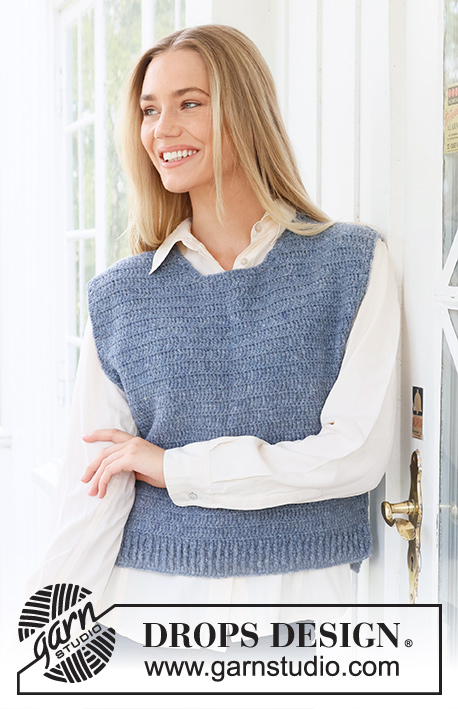 |
|||||||||||||||
Crocheted vest in DROPS Sky. The piece is worked bottom up with relief-pattern and split in the sides. Sizes S - XXXL.
DROPS 236-31 |
||||||||||||||||
|
------------------------------------------------------- EXPLANATIONS FOR THE PATTERN: ------------------------------------------------------- CROCHET INFORMATION: Each row of double-treble crochets starts with 4 chain stitches, these 4 chain stitches are worked extra and do not count in the number of stitches. Each row of double crochets starts with 1 chain stitch, this chain stitch is worked extra and does not count in the number of stitches. Around the armholes and neck (round 2) the first treble crochet is replaced by 3 chain stitches, the round ends with 1 slip stitch in the 3rd chain stitch at the beginning of the round. CHAIN STITCH: If you work outermost on the hook the chain stitch will often be too tight; 1 chain stitch should be as long as 1 double crochet/double-treble crochet is wide. PATTERN: See diagrams A.1 and A.2. DECREASE TIP-1: Insert the hook through the first stitch and pick up the strand, insert the hook through the next stitch and pick up the strand, make 1 yarn over and pull it through all 3 loops on the hook (1 double crochet decreased). DECREASE TIP-2 (armholes and back of neck): Always decrease on a row of double-treble crochets! Beginning of row: Replace the number of stitches to be decreased with 1 slip stitch. End of row: Do not work the number of stitches to be decreased. DECREASE TIP-3 (front of neck): Always decrease on a row of double-treble crochets! DECREASE 2 DOUBLE-TREBLE CROCHETS: Work 1 double-treble crochet in each of the next 2 stitches, but wait with the last yarn over and pull-through on both double-treble crochets, work 1 double-treble crochet in the next stitch and pull it through all 4 loops on the hook (2 double-treble crochets decreased). DECREASE 1 DOUBLE-TREBLE CROCHET: Work 1 double-treble crochet, but wait with the last yarn over and pull-through, work 1 double-treble crochet in the next stitch and pull the last yarn over through all 3 loops on the hook (1 double-treble crochet decreased). ------------------------------------------------------- START THE PIECE HERE: ------------------------------------------------------- VEST – SHORT OVERVIEW OF THE PIECE: The back and front pieces are worked separately, back and forth and bottom up. The piece is sewn together and edges worked around the armholes and neck. BACK PIECE: Read CHAIN STITCH and CROCHET INFORMATION and work 87-95-103-111-123-133 chain stitches (including 4 chain stitches to turn) with hook size 4 mm and DROPS Sky. Work 1 double-treble crochet in the 5th chain stitch from the hook, then 1 double-treble crochet in each stitch = 83-91-99-107-119-129 stitches. Turn and work 1 double crochet in each stitch. Work as follows from the right side: Start with 4 chain stitches as before, work A.1 until there is 1 stitch left, work the first stitch in A.1 so the pattern is symmetrical. Work A.1 back and forth until A.1 has been worked 3 times in height – AT THE SAME TIME at the end of the last row of double crochets, decrease 1 stitch by working 2 double crochets together – read DECREASE TIP-1 = 82-90-98-106-118-128 stitches. Work A.2 with alternate rows of double-treble crochets and double crochets. REMEMBER THE CROCHET TENSION! When the piece measures 25-26-27-28-29-30 cm, start to work the armholes – adjust so the next row is a row of double-treble crochets. Cut and fasten the strand. Work 1 row of double-treble crochets over the middle 76-82-88-94-102-108 stitches (3-4-5-6-8-10 stitches decreased on each side). Continue to decrease on each side on each row of double-treble crochets as follows: Decrease 1 double-treble crochet 2-3-4-6-8-9 times on each side – read DECREASE TIP-2 = 72-76-80-82-86-90 stitches. Continue the pattern until the piece measures 48-50-52-54-56-58 cm and the next row is a row of double-treble crochets. Finish each shoulder separately. RIGHT SHOULDER (when the garment is worn): Work the first 22-24-25-26-27-29 stitches, turn and work double crochets back. On the next row decrease 1 stitch by the neck – read DECREASE TIP-2 = 21-23-24-25-26-28 stitches on the shoulder. Work until the piece measures 52-54-56-58-60-62 cm. Cut and fasten the strand. LEFT SHOULDER: Start from the right side (a row of double-treble crochets), skip the next 28-28-30-30-32-32 stitches for the neck and work double-treble crochets over the last 22-24-25-26-27-29 stitches. Turn and work double crochets back. On the next row decrease 1 stitch by the neck – remember DECREASE TIP-2 = 21-23-24-25-26-28 stitches on the shoulder. Work until the piece measures 52-54-56-58-60-62 cm. Cut and fasten the strand. FRONT PIECE: Work 87-95-103-111-123-133 chain stitches (including 4 chain stitches to turn) with hook size 4 mm and DROPS Sky. Work 1 double-treble crochet in the 5th chain stitch from the hook, then 1 double-treble crochet in each stitch = 83-91-99-107-119-129 stitches. Turn and work 1 double crochet in each stitch. Work as follows from the right side: Start with 4 chain stitches as before, work A.1 until there is 1 stitch left, work the first stitch in A.1 so the pattern is symmetrical. Work A.1 back and forth until A.1 has been worked 2 times in height (front piece is shorter than the back) – AT THE SAME TIME at the end of the last row of double crochets, decrease 1 stitch by working 2 double crochets together = 82-90-98-106-118-128 stitches. Work A.2 with alternate rows of double-treble crochets and double crochets. When the piece measures 23-24-25-26-27-28 cm, start to work the armholes – adjust so the next row is a row of double-treble crochets. Cut and fasten the strand. Work 1 row of double-treble crochets over the middle 76-82-88-94-102-108 stitches (3-4-5-6-8-10 stitches decreased on each side). Continue to decrease on each side on each row of double-treble crochets as follows: Decrease 1 double-treble crochet 2-3-4-6-8-9 times on each side = 72-76-80-82-86-90 stitches. Continue the pattern until the piece measures 42-44-45-47-48-50 cm and the next row is a row of double-treble crochets. Finish each shoulder separately. LEFT SHOULDER (when the garment is worn): Work the first 26-28-29-30-32-34 stitches, turn and work double crochets back. Continue the pattern and decrease at the end of each row of double-treble crochets as described below (when decreasing 2 double-treble crochets work over the last 3 stitches by the neck, when decreasing 1 double-treble crochet work over the last 2 stitches by the neck): Decrease 2 double-treble crochets by the neck 2 times, then 1 double-treble crochet 1-1-1-1-2-2 times – read DECREASE TIP-3. After the last decrease there are 21-23-24-25-26-28 stitches on the shoulder. Work until the piece measures 50-52-54-56-58-60 cm. Cut and fasten the strand. RIGHT SHOULDER: Start from the right side (a row of double-treble crochets), skip the first 20-20-22-22-22-22 stitches for the neck and work double-treble crochets over the last 26-28-29-30-32-34 stitches, turn and work double crochets back. Continue the pattern and decrease at the beginning of each row of double-treble crochets as follows: Decrease 2 double-treble crochets by the neck 2 times, then 1 double-treble crochet 1-1-1-1-2-2 times – remember DECREASE TIP-3. After the last decrease there are 21-23-24-25-26-28 stitches on the shoulder. Work until the piece measures 50-52-54-56-58-60 cm. Cut and fasten the strand. ASSEMBLY: Sew the shoulder seams edge to edge. Sew the side seams edge to edge, leaving 10 cm split at the bottom of the front piece (12 cm on the back). SLEEVE-EDGES: Start at the bottom of the armhole with hook size 3.5 mm and work as follows: ROUND 1: * Work 1 double crochet in the double-crochet row, 3 chain stitches, skip the double-treble crochet row *, work from *-* round the armhole, finish with 1 slip stitch in the first double crochet ROUND 2: Remember CROCHET INFORMATION, work 1 slip stitch around the first chain-space, then 3 treble crochets around each of the next 3 chain-spaces, 4 treble crochets around each chain-space as far as the middle 6 chain-spaces on the shoulder, work 3 treble crochets around each of the next 6 chain-spaces, 4 treble crochets around each chain-space until there are 3 chain-spaces left and 3 treble crochets around each of these last chain-spaces. Work a similar edge around the other armhole. EDGE AROUND NECK: Start at one shoulder seam with hook size 3.5 mm and work as follows: ROUND 1: * Work 1 double crochet in the first/next stitch, 3 chain stitches, skip 1 double-treble crochet row *, work from *-* around the neck, finish with 1 slip stitch in the first double crochet. ROUND 2: Work 1 slip stitch around the first chain-space, then 4 treble crochets around each chain-space. |
||||||||||||||||
Diagram explanations |
||||||||||||||||
|
||||||||||||||||
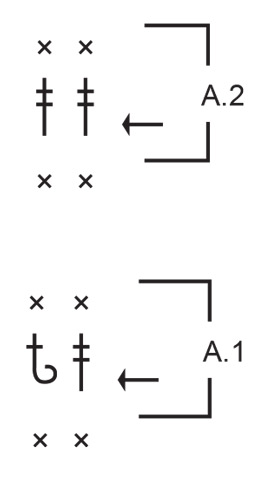
|
||||||||||||||||

|
||||||||||||||||
|
Have you made this or any other of our designs? Tag your pictures in social media with #dropsdesign so we can see them! Do you need help with this pattern?You'll find tutorial videos, a Comments/Questions area and more by visiting the pattern on garnstudio.com. © 1982-2024 DROPS Design A/S. We reserve all rights. This document, including all its sub-sections, has copyrights. Read more about what you can do with our patterns at the bottom of each pattern on our site. |
||||||||||||||||







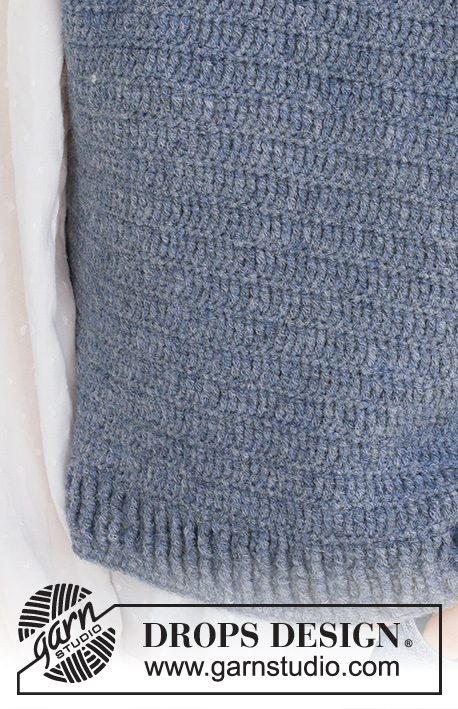

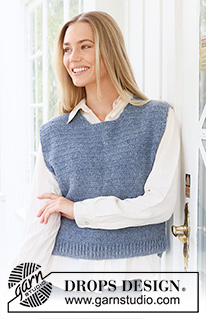
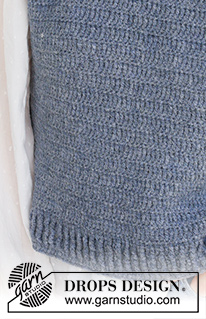












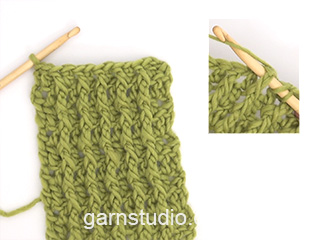

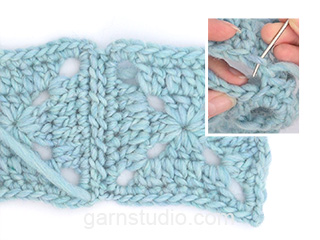








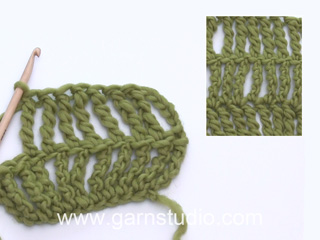









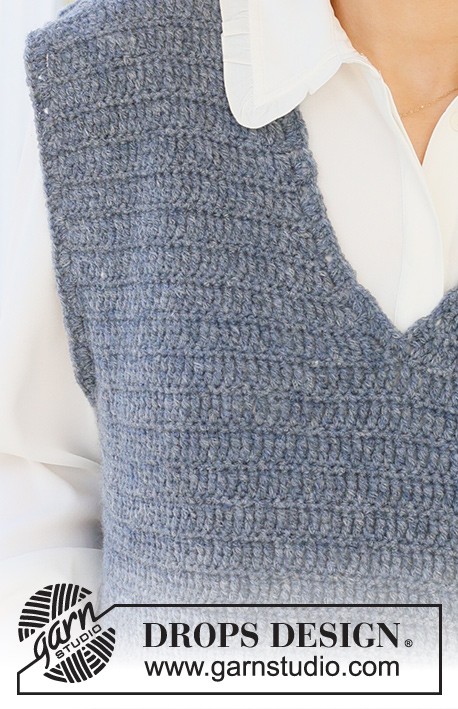








Comments / Questions (10)
Hej. Jeg har svært ved at forstå A1. Skal det forstås som om at den sidste maske i anden række skal være en relief-firedobbeltstangmaske? Eller skal det læses som hver anden maske i rækken skal være en relief-firedobbeltstangmaske? Jeg kan ikke læse mig frem til hvordan jeg skal forstå diagrammet
31.03.2024 - 20:18DROPS Design answered:
Hej Asta, Ja hver 2.maske i A.1 er en relief-firedobbeltstangmaske :)
05.04.2024 - 12:16Jeg er i tvivl om rækken før første række af A.1: Af opskriften fremgår, at man skal hækle "1 fastmaske i hver dobbeltstangmaske fra forrige række". Men af diagrammet ser det ud til, at første række med A.1 skal hækles ned i en række med dobbeltstangmasker (og altså ikke i en række med fastmasker). Hvordan skal man korrekt gøre? (vistnok samme spørgsmål som Daniella 03.01.2024)
12.03.2024 - 09:03DROPS Design answered:
Hej Sofie, jo hver. 2 række er fastmasker, så du hækler 1 række fastmasker inden du starter A.1 :)
19.03.2024 - 14:40Cześć, kiedy należy wykonać słupek poczwórny w części a1? Nie do końca rozumiem kiedy należy go zrobić. Czy należy go zrobić jako ostatni w rzędzie podwójnych słupków czy jako ostatni w rzędzie oczek ścisłych? Proszę o pomoc. Czy jeżeli od początku będę robić schemat a2 to robótka się uda ?
22.01.2024 - 23:17DROPS Design answered:
Witaj Klaudio, słupki poczwórne są wykonywane w rzędzie słupków podwójnych, naprzemiennie raz słupek podwójny, raz słupek poczwórny. Dzięki nim brzeg robótki będzie miał wygląd ściągacza. Jak wykonać słupki nakładane (na filmie są zwykłe słupki, a nie poczwórne, ale technika jest analogiczna) znajdziesz TUTAJ. Oczywiście możesz wykonać kamizelkę bez tego ściągacza na dole i wtedy zacznij od schematu A.2. Pozdrawiamy!
23.01.2024 - 08:07Hej! Jag föstår inte hur man ska börja med A1. I diagrammen står det att man ska börja med relief fyrstolparna (och att dubbelstolpar innan är redan virkade). Men i beskrivningen så står det att man ska virka en rad fastmaskor och sen direkt börja med A1. Hur ska man göra?
03.01.2024 - 17:47Pour le dos il est écrit " diminuer pour les emmanchures tous les rangs de double brides (D2) jusqu'à ce que l'ouvrage mesure 48cm" La diminution D2 répétée sur de nombreux rangs entraîne la création d'un décalage en escalier, est ce normal ou devrais je faire une autre sorte de diminution plus diagonale ?
21.11.2023 - 11:17DROPS Design answered:
Bonjour, vous pouvez procéder soit comme dans les explications, et les "escaliers" seront ensuite compensés/cachés lors de la bordure des emmanchures, ou bien vous pouvez diminuer différemment si vous le préférez. Bon crochet!
21.11.2023 - 16:01Bij de tekening van 1.A en 2.A is er telkens een pijl. Is dat op weer te geven dat je eerst een vaste haakt en dan een dubbel stokje. En als allerlaatste steek weer een 2X een dubbel stokje haakt?
14.08.2023 - 17:22DROPS Design answered:
Dag Nel,
Nee, de pijl geeft aan wat patroon A.1 of A.2 is. De toer die eronder staat is dus niet patroon A.1 of A.2; deze staat er alleen bij om te laten zien hoe je de steken in de vorige toer haakt.
20.08.2023 - 15:48Das Bündchen kann ich nicht erkennen und es ist in der Anleitung nicht beschrieben. Wie wird das gehäkelt? Bedanke mich für eine Beschreibung.
18.03.2023 - 14:48DROPS Design answered:
Liebe Frau Eitel, Bündchen wird wie in A.1 gehäkelt, dh: *1 Doppelstäbchen in die nächste Masche, 1 Relief-Doppelstäbchen in die nächste Masche*, von *-* wiederholen. In diesem Video zeigen wir, wie man solche Bündchen häkelt, aber im Video wird es Stäbchen gehäkelt, in dieses Modell will man Doppelstäbchen häkeln. Viel Spaß beim häkeln!
20.03.2023 - 08:21Hi again, The pattern above says its alternating rows of double treble crochet and double crochet (treble crochets and single crochets in the US English version) rather than the repeat of a row of treble and then row of double crochets as you suggested in the previous answer. Could you confirm which one it is please? Thank you :)
29.09.2022 - 13:12DROPS Design answered:
Dear Phil, yes correct, sorry, it should be treble crochets/single crochets (US) or double-treble crochets / double crochets (UK) . Happy crocheting!
29.09.2022 - 13:41Are the instructions for the gauge swatch definitely correct? 11 rows makes it far too long and rectangular. 10cm is about 8.5-9 rows on my swatch (which is 10cm wide). Would just like to make sure I’m not totally off before starting the vest!
28.09.2022 - 22:05DROPS Design answered:
Dear Phil, make sure you work alternately (1 row with treble crochets, 1 row with double crochets), repeat from (to) to get the structured pattern; you should then get 11 rows with that pattern = 10 cm in height. Try to make longer stitches in height if yours are too tight. Happy crocheting!
29.09.2022 - 08:43Hæklet vest med rund hals
06.08.2022 - 02:58